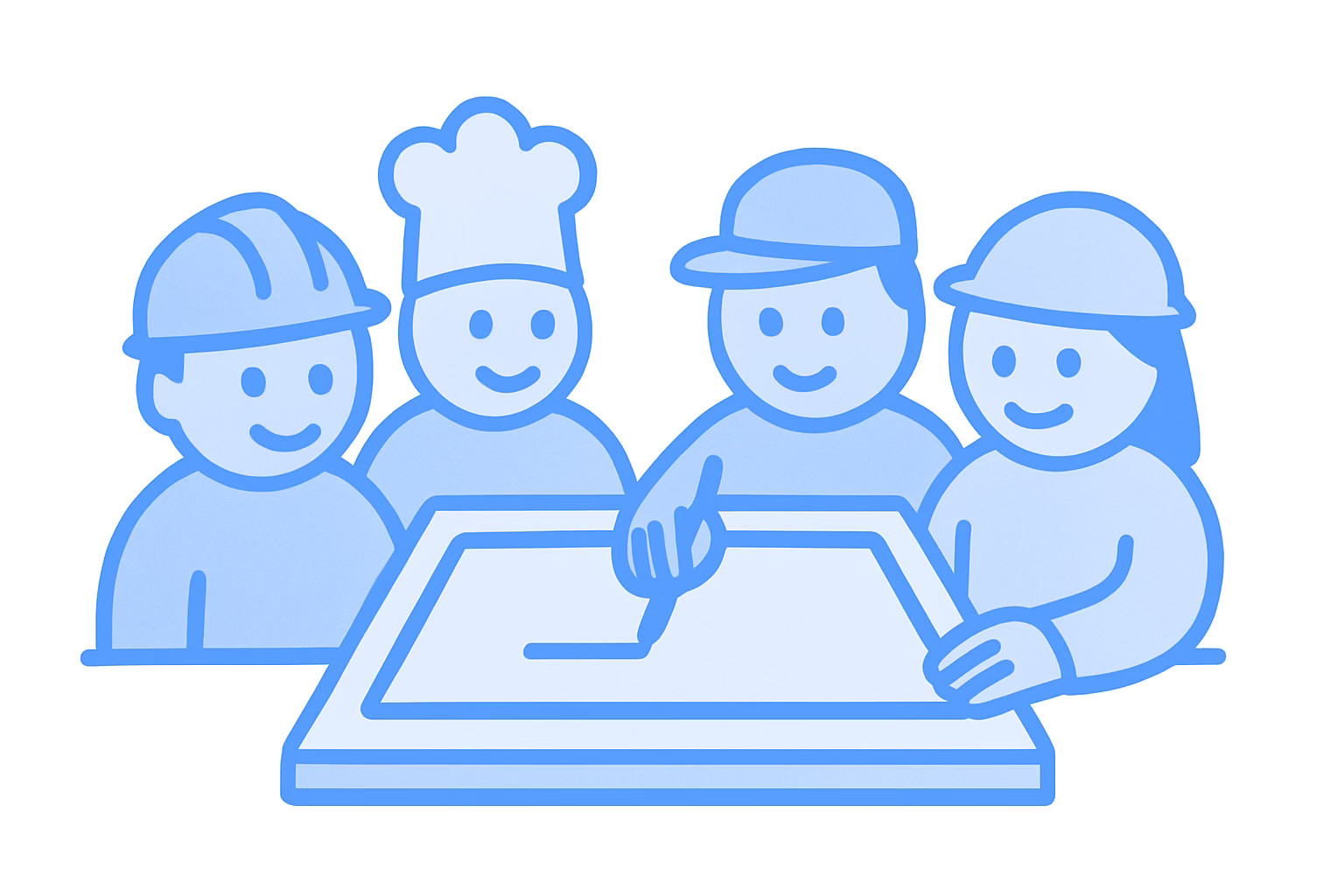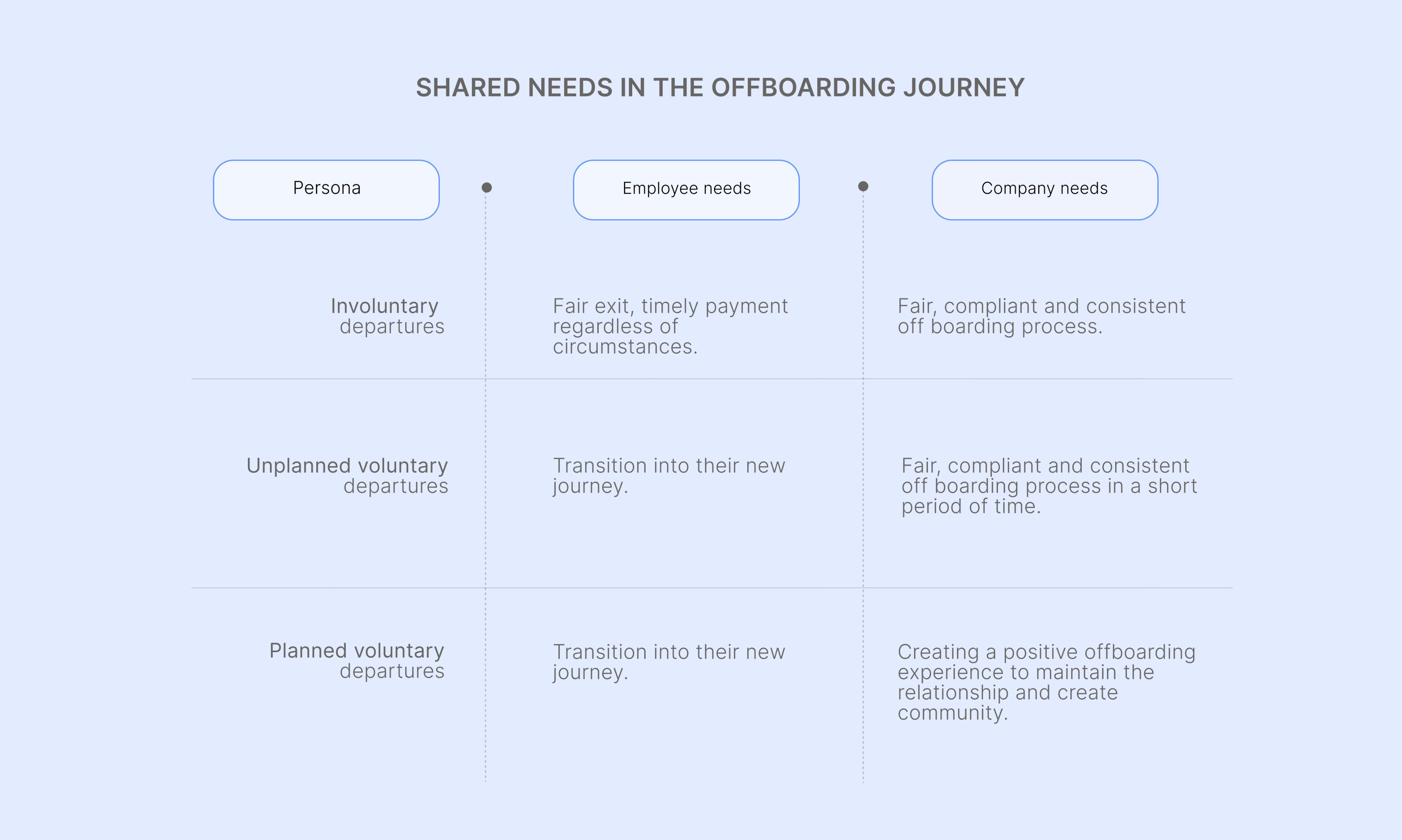
Farewell with Care
Transforming the employee offboarding experience from administrative burden to thoughtful farewell journey that honors contributions and strengthens organizational culture.
Human-Centered Design
Process Design
Change Management
100%
Documentation compliance
66%
Reduccion processing time per termination
60%
Increase in completed exit interviews
Consistent
Dignified departure experience for all
Project Overview
Employee departures mark a pivotal chapter in the employee lifecycle, one that should be handled with dignity, gratitude, and care. This project reimagined offboarding from a routine administrative task into a structured, human-centered process that balanced compliance, efficiency, and empathy. By honoring contributions and streamlining transitions, the new system not only improved the employee experience but also reinforced the company’s culture and values.
"The exit experience is the last chapter in an employee's journey. Make it one worth remembering positively."

Arianna Huffington
Author
"A graceful exit process demonstrates your company's values more clearly than any mission statement ever could."

Brené Brown
Writer and Psychologist
My role
Strategic Lead & Implementation Manager
- Analyzed existing workflows and identified optimization opportunities
- Aligned HR, IT, Finance, and management needs through stakeholder collaboration
- Configured HRIS and Monday.com to support digital offboarding workflows
- Led change management and facilitated training for smooth adoption
Project goals
- Enable managers to hold meaningful farewell and transition conversations
- Streamline administrative processes and ensure compliance
- Enable managers to hold meaningful farewell and transition conversations
- Strengthen the employer brand through thoughtful and respectful departures.
Impact
- Cut admin workload by 66%, freeing HR time for higher-value work.
- Raised exit interview participation from 10% → 70%, improving retention insights.
- Achieved 100% documentation compliance and reduced final paycheck errors to zero.
- Improved manager confidence with clear, repeatable offboarding guidance.
- Strengthened employee experience and employer brand through consistent, dignified transitions.
The Challenge
Rapid organizational growth exposed the limitations of traditional paper-based offboarding, creating both operational inefficiencies and human challenges.
Current State Problems
Process Fragmentation
Paper workflows led to disjointed communication between departments.
Compliance Risks
Manual handling increased errors and delays.
Manager Burden
Heavy administrative workloads left minimal time for meaningful conversations.
Inconsistent Experience
Offboarding quality varied across teams.
Human Impact
Missed Moments for Connection
Opportunities to celebrate employee contributions and gather valuable insights were sometimes overlooked.
Consistency Gaps
High workloads or varying approaches among managers occasionally led to uneven offboarding experiences.
Positive Lasting Impressions
There was untapped potential to ensure every departing employee left with a strong, dignified impression of the organization.
Unified Experience
The process did not consistently reflect company values.

Discovery Phase
The discovery phase involved a deep-dive into the needs and challenges of each key stakeholder group to ensure a robust offboarding process. By combining technical requirements with a focus on the human element, this phase laid the foundation for creating dignified and seamless departures.
Key Research Stakeholder Insights
Research across teams highlighted critical needs shaping a streamlined and consistent offboarding process.
HR Team
Compliance & Documentation
• Compliance requirements
• Documentation procedures
• Exit interview processes
• Feedback collection methods

Managers
Process & Support Needs
• Current offboarding approaches
• Pain points and challenges
• Resource constraints
• Support needs
IT Department
Security & Access
• System access management
• Security protocols
• Automation opportunities
• Technical requirements

Finance/Payroll
Final Payments & Benefits
• Final payment processes
• Benefits termination
• System requirements
• Compliance tracking
Key Research Employee Insights
Research across received feedback from the HR team and Managers. We gather the most common circumstances of our primary user, the employee would be leaving the company.


Design Phase
Creating a framework that balances administrative efficiency with human dignity and meaningful connections.
Design Principles
During the design phase, a thoughtful framework was created to balance administrative efficiency with human dignity. The following principles guided the development of this approach:
Honor Every Journey
Recognize and respect every employee’s contributions, ensuring meaningful and dignified departures.
Proactive Communication
Use clear communication triggers and timelines to keep all stakeholders informed and aligned.
Enable Connection
Leverage technology to simplify administrative tasks and prioritize time for impactful conversations.
Scalable Simplicity
Design solutions that grow with the organization while remaining intuitive and easy to use.
Maintain Consistency
Apply standardized processes to ensure fairness and reliability, while allowing flexibility for unique situations.
IMPLEMENTATION Phase
Turning design principles into actionable workflows through digital tools.
System Integration Overview

- Consistency (HRIS workflows)
Ensured consistent offboarding experiences through HRIS checklists tailored to different scenarios (voluntary vs. involuntary, role-specific, bilingual). This reduced confusion, eliminated missed steps, and safeguarded sensitive information with privacy-focused document handling.
- Clarity (Permissions and alerts)
Built clarity and confidence into the process by implementing automated alerts and permissions. This kept stakeholders aligned, surfaced retention opportunities earlier, and ensured tasks were completed on time without extra manual coordination.
- Accountability (Monday.com tracking)
Introduced accountability across departments with Monday.com dashboards. This gave managers and teams real-time visibility into outstanding tasks, prevented items from slipping through the cracks, and ensured a smoother, shared responsibility for the offboarding journey.
- Archiving & Reporting
Turned offboarding into a learning opportunity by centralizing data and streamlining exit feedback. Enhanced reporting provided leadership with actionable insights, while quick document access improved compliance and decision-making across HR, IT, and Finance.
Results & Impact
The transformation delivered measurable improvements in efficiency, compliance, and most importantly, human dignity.
Quantitative Results
Administrative Time
Reduced time spent on paperwork
-66%
Exit Interview Completion
Increased participation rate from 10% baseline
70%
Documentation Compliance
Perfect compliance achieved
100%
Final Paycheck Errors
From 15 last payment complications year prior.
ZERO
Qualitative Impact
Enhanced Employee Experience
- Consistent support across all departure types.
- Strengthened communication during transitions, improving clarity and fairness.
- Maintained respectful, dignified treatment for all employees.
Stronger Manager Enablement
- More time for meaningful farewell conversations.
- Delivered clear guidance for handling sensitive situations.
- Increased confidence managing exits.
Organizational Benefits
- Strengthened employer branding through dignified offboarding.
- Early interventions improved retention opportunities.
- Amplified feedback collection, fostering better organizational insights.
- Bolstered company culture by aligning processes with core values.
Key Learnings
The project revealed vital insights into the balance between digital efficiency and human dignity, shaping more effective employee lifecycle management strategies.
Success insights
Digital Enhancement, Not Replacement
Technology should augment human interaction, ensuring that personal connections remain central.
Consistent Yet Personal
Standardized processes can coexist with customized, individual-focused experiences.
Early Notification Value
Proactive communication enables timely interventions and strengthens decision-making.
Implementation Learnings
Power of Exit Conversations
Structured discussions uncovered retention opportunities and addressed core employee concerns.
Continuous Manager Support
Ongoing training and timely reminders empower managers to handle transitions effectively.
Cultural Alignment
Dignified offboarding processes reinforce organizational values and enhance the company’s employer brand.
Future Opportunities
The next phase of innovation can deepen the offboarding experience by focusing on personalization, insights, and long-term connections.
Enhanced Personalization
- Create unique farewell experiences
- Tailor departures to roles
- Personalize recognition efforts
- Develop alumni engagement plans
Advanced Analytics
- Study departure trends
- Spot retention opportunities
- Evaluate manager performance
- Monitor alumni networks
Alumni Engagement
- Build strong post-departure ties
- Create re-hire programs
- Establish alumni referrals
- Foster brand advocates
Farewell with Care
Transforming the employee offboarding experience from administrative burden to thoughtful farewell journey that honors contributions and strengthens organizational culture.
Human-Centered Design
Process Design
Change Management

100%
Documentation compliance
66%
Reduction processing time per departure
60%
Increase in completed exit interviews
Consistent
Dignified departure experience for all
Project Overview
Employee departures mark a pivotal chapter in the employee lifecycle, one that should be handled with dignity, gratitude, and care. This project reimagined offboarding from a routine administrative task into a structured, human-centered process that balanced compliance, efficiency, and empathy. By honoring contributions and streamlining transitions, the new system not only improved the employee experience but also reinforced the company’s culture and values.
"The exit experience is the last chapter in an employee's journey. Make it one worth remembering positively."

Arianna Huffington
Author
"A graceful exit process demonstrates your company's values more clearly than any mission statement ever could."

Brené Brown
Writer and Psychologist
My role
Strategic Lead & Implementation Manager
- Analyzed existing workflows and identified optimization opportunities
- Aligned HR, IT, Finance, and management needs through stakeholder collaboration
- Configured HRIS and Monday.com to support digital offboarding workflows
- Led change management and facilitated training for smooth adoption
Project goals
- Enable managers to hold meaningful farewell and transition conversations
- Streamline administrative processes and ensure compliance
- Enable managers to hold meaningful farewell and transition conversations
- Strengthen the employer brand through thoughtful and respectful departures.
Impact
- Cut admin workload by 66%, freeing HR time for higher-value work.
- Raised exit interview participation from 10% → 70%, improving retention insights.
- Achieved 100% documentation compliance and reduced final paycheck errors to zero.
- Improved manager confidence with clear, repeatable offboarding guidance.
- Strengthened employee experience and employer brand through consistent, dignified transitions.
The Challenge
Rapid organizational growth exposed the limitations of traditional paper-based offboarding, creating both operational inefficiencies and human challenges.
Current State Problems
Process Fragmentation
Paper workflows led to disjointed communication between departments.
Compliance Risks
Manual handling increased errors and delays.
Manager Burden
Heavy administrative workloads left minimal time for meaningful conversations.
Inconsistent Experience
Offboarding quality varied across teams.
Human Impact
Missed Moments for Connection
Opportunities to celebrate employee contributions and gather valuable insights were sometimes overlooked.
Consistency Gaps
High workloads or varying approaches among managers occasionally led to uneven offboarding experiences.
Positive Lasting Impressions
There was untapped potential to ensure every departing employee left with a strong, dignified impression of the organization.
Unified Experience
The process did not consistently reflect company values.

User Center Design Process
Discovery Phase
The discovery phase involved a deep-dive into the needs and challenges of each key stakeholder group to ensure a robust offboarding process. By combining technical requirements with a focus on the human element, this phase laid the foundation for creating dignified and seamless departures.
Key Research Stakeholder Insights
Research across teams highlighted critical needs shaping a streamlined and consistent offboarding process.
HR Team
Compliance & Documentation
• Compliance requirements
• Documentation procedures
• Exit interview processes
• Feedback collection methods

Managers
Process & Support Needs
• Current offboarding approaches
• Pain points and challenges
• Resource constraints
• Support needs
IT Department
Security & Access
• System access management
• Security protocols
• Automation opportunities
• Technical requirements

Finance/Payroll
Final Payments & Benefits
• Final payment processes
• Benefits termination
• System requirements
• Compliance tracking
Key Research Employee Insights
Research across received feedback from the HR team and Managers. We gather the most common circumstances of our primary user, the employee would be leaving the company.


Design Phase
Creating a framework that balances administrative efficiency with human dignity and meaningful connections.
Design Principles
During the design phase, a thoughtful framework was created to balance administrative efficiency with human dignity. The following principles guided the development of this approach:
Honor Every Journey
Recognize and respect every employee’s contributions, ensuring meaningful and dignified departures.
Proactive Communication
Use clear communication triggers and timelines to keep all stakeholders informed and aligned.
Enable Connection
Leverage technology to simplify administrative tasks and prioritize time for impactful conversations.
Scalable Simplicity
Design solutions that grow with the organization while remaining intuitive and easy to use.
Maintain Consistency
Apply standardized processes to ensure fairness and reliability, while allowing flexibility for unique situations.
IMPLEMENTATION Phase
Turning design principles into actionable workflows through digital tools.
- Consistency (HRIS workflows)
Ensured consistent offboarding experiences through HRIS checklists tailored to different scenarios (voluntary vs. involuntary, role-specific, bilingual). This reduced confusion, eliminated missed steps, and safeguarded sensitive information with privacy-focused document handling.
- Clarity (Permissions and alerts)
Built clarity and confidence into the process by implementing automated alerts and permissions. This kept stakeholders aligned, surfaced retention opportunities earlier, and ensured tasks were completed on time without extra manual coordination.
- Accountability (Monday.com tracking)
Introduced accountability across departments with Monday.com dashboards. This gave managers and teams real-time visibility into outstanding tasks, prevented items from slipping through the cracks, and ensured a smoother, shared responsibility for the offboarding journey.
- Archiving & Reporting
Turned offboarding into a learning opportunity by centralizing data and streamlining exit feedback. Enhanced reporting provided leadership with actionable insights, while quick document access improved compliance and decision-making across HR, IT, and Finance.
System Integration Overview

Results & Impact
The transformation delivered measurable improvements in efficiency, compliance, and most importantly, human dignity.
Quantitative Results
Administrative Time
Reduced time spent on paperwork
-66%
Exit Interview Completion
Increased participation rate from 10% baseline
70%
Documentation Compliance
Perfect compliance achieved
100%
Final Paycheck Errors
From 15 last payment complications year prior.
ZERO
Qualitative Impact
Enhanced Employee Experience
- Consistent support across all departure types.
- Strengthened communication during transitions, improving clarity and fairness.
- Maintained respectful, dignified treatment for all employees.
Stronger Manager Enablement
- More time for meaningful farewell conversations.
- Delivered clear guidance for handling sensitive situations.
- Increased confidence managing exits.
Organizational Benefits
- Strengthened employer branding through dignified offboarding.
- Early interventions improved retention opportunities.
- Amplified feedback collection, fostering better organizational insights.
- Bolstered company culture by aligning processes with core values.
Key Learnings
The project revealed vital insights into the balance between digital efficiency and human dignity, shaping more effective employee lifecycle management strategies.
Success insights
Digital Enhancement, Not Replacement
Technology should augment human interaction, ensuring that personal connections remain central.
Consistent Yet Personal
Standardized processes can coexist with customized, individual-focused experiences.
Early Notification Value
Proactive communication enables timely interventions and strengthens decision-making.
Implementation Learnings
Power of Exit Conversations
Structured discussions uncovered retention opportunities and addressed core employee concerns.
Continuous Manager Support
Ongoing training and timely reminders empower managers to handle transitions effectively.
Cultural Alignment
Dignified offboarding processes reinforce organizational values and enhance the company’s employer brand.
Future Opportunities
The next phase of innovation can deepen the offboarding experience by focusing on personalization, insights, and long-term connections.
Enhanced Personalization
- Create unique farewell experiences
- Tailor departures to roles
- Personalize recognition efforts
- Develop alumni engagement plans
Advanced Analytics
- Study departure trends
- Spot retention opportunities
- Evaluate manager performance
- Monitor alumni networks
Alumni Engagement
- Build strong post-departure ties
- Create re-hire programs
- Establish alumni referrals
- Foster brand advocates
